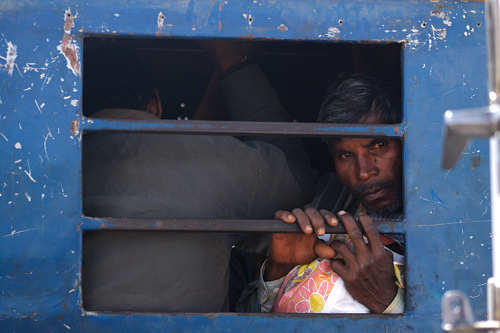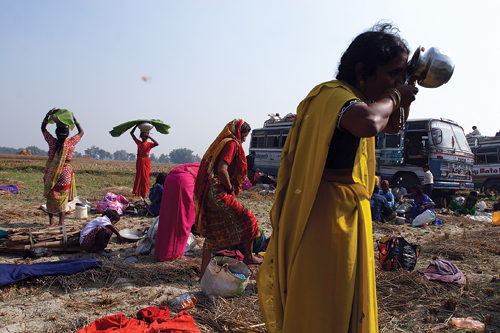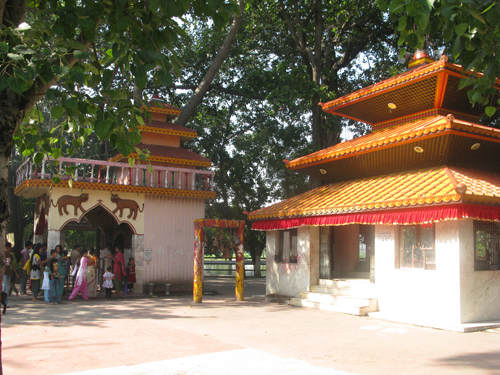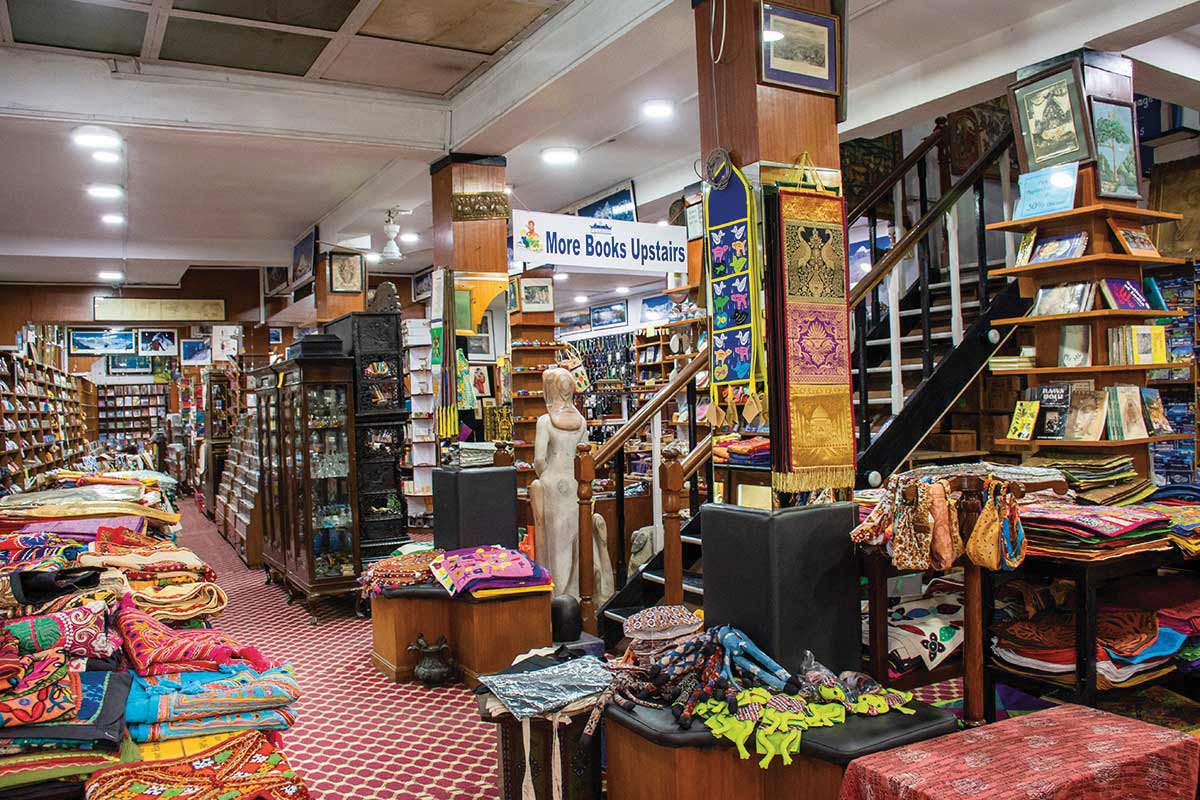On the trail of the largest anumal sacrifice-festival in the world
In 2009, the Gadhi Mai tmeple at Bariyarpur, about 150km southeast of Kathmandu hogged national and regional newspaper headlines followed by a worldwide international media stir at the onset of a month-long mela (fair) where a mass sacrifice of animals in thousands is made as a ritualistic act of cult worship. The mela is held every five years in mid-Kartik (Oct-Nov). Despite the furor, national and international, including staged protests, impassioned pleas, urgent petitioning, vocal protests, and vehement denunciations – the centuries-old festival, ‘the largest’, ‘bloodiest’, ‘cruelest’, ‘goriest’, and ‘most barbaric’ animal sacrifice the world over, was held as scheduled.
 En-route Historic Places
En-route Historic Places
My wife and I had not been to the Tarai plains for a long time. She wished to make a pilgrimage to a Hindu shrine and so we went. We opted to drive to this holy shrine via the recently opened Dakshinkali-Sisneri-Bhimphedi highway for its short distance. Rugged hills, small pockets of woods, terraced fields that dropped into deep gorges, clusters of small houses that dotted the surrounding hills and burgeoning roadside settlements made up the rustic landscape.
 After Sisneri, the road merged with another road (the Pharping-Phakhel Kulekhani Road) to form a single highway to Bhimphedi. En route, we stopped by the historic Chisapani Gadhi. We were baffled as the caretaker informed us that women were barred from entry here. The explanation he offered was that the sight of women, the weaker sex, inside the fort tended to weaken the soldiers in their resolve. Surprisingly, this unwritten rule is still observed. The strategic mountain top defense base was built to withstand the British invasion during the Nepal Company war (1814-1816). But the forces at Chisapani Gadhi never got into direct combat with the East India Company’s forces as their attempt was thwarted by the stalwart Gurkha soldiers under the command of Col. Ranabir Singh Thapa at Makwanpur Gadhi, 13km northeast of Hetauda. Save for the Bhairabnath temple, a handful of cannons, piles of iron-balls and the hefty kalitop, the fort looked in a pitiably run-down state.
After Sisneri, the road merged with another road (the Pharping-Phakhel Kulekhani Road) to form a single highway to Bhimphedi. En route, we stopped by the historic Chisapani Gadhi. We were baffled as the caretaker informed us that women were barred from entry here. The explanation he offered was that the sight of women, the weaker sex, inside the fort tended to weaken the soldiers in their resolve. Surprisingly, this unwritten rule is still observed. The strategic mountain top defense base was built to withstand the British invasion during the Nepal Company war (1814-1816). But the forces at Chisapani Gadhi never got into direct combat with the East India Company’s forces as their attempt was thwarted by the stalwart Gurkha soldiers under the command of Col. Ranabir Singh Thapa at Makwanpur Gadhi, 13km northeast of Hetauda. Save for the Bhairabnath temple, a handful of cannons, piles of iron-balls and the hefty kalitop, the fort looked in a pitiably run-down state.
Next came the town of Bhimphedi, the last point (before the Tribhuwan Highway came in 1956) where the weary trail walkers from Thankot (Kathmandu) – the only ancient trail linking Nepal to India – caught buses and trucks south to the border town of Birgunj and onward to Raxaul, India. At Bhainse, the road merged with the very first highway of Nepal, the Tribhuwan Rajpath, or By-Road, as it was widely known. Next we passed through the industrial town of Hetauda. Tall Ashoka trees (Saraca asoca) flank the road on the high street, successfully enhancing the city’s appearance. But the increase in congestion and noise was pronounced. We stopped for lunch at Lido Restaurant, a favourite that is older is than a decade.
After Hetauda, the road traversed through the beautiful wooded Chure hills until the plains began at Amlekhgunj. We sped past ramshackle tin sheds at Amlekhgunj, once a meter gauge railway station for freight transport (in the late 1920s clear into the 1950s) from and to the border town of Raxaul, India. Signs of habitation faded as we entered the long stretch of the famous Charkoshe Jhadi (12km stretch of jungle), once notorious as a malaria-rife dense forest and a popular hunting destination for early rulers and foreign dignitaries of Nepal. Soon we were deep into the chaos of urban sprawl as we hit the bustling Jitpur on the outskirts of Birgunj.
 The Incredible Tarai
The Incredible Tarai
Birgunj had outgrown the choked-up traffic, pouring crowds, congestion, and deafening noise. The streets were seething masses of rickshaws, cars, motorbikes, bicycles, people, tangaas (horse-pulled carts), and push-carts. For the night, we checked into a hotel at Adarsha Nagar, the city’s commercial hub. We soon retired for the night but not before a thrilling rickshaw ride around the streets and back alleys of Birgunj. What tuk-tuks (motorized rickshaws) are to Bangkok, rickshaws are to Birgunj.
We started for the Gadhi Mai temple early the next day. As we left Birgunj, it was gearing up for the hectic day ahead. Whiffs of food cooking wafted in through our car window. People crowded the teahouses for naasta (breakfast) as shopkeepers ladled out golden crisp jalebis on trays from huge karais (iron saucepans) at their shop fronts. A typical morning tarai teahouse nasta includes hot puris, a jalebi or two, potato curry and sweet tea.
Stretching frm the country’s east to its west, the tarai, east to west, is a vast plain. As we drove deeper, miles after staggering mile of endless cultivated land stretched out as far as we could see. And the smell - there was no mistaking the odor of burning dead leaves and dung-cakes, which was followed by a typical Tarai smell, the pungent aroma of molasses being made. Clusters of tiny farmsteads and clumps of mangos, the evergreen jamun and coconut trees dotted the distant fields. Mixed roadside settlements: ramshackle mud-and-thatch huts, improved brick houses, and makeshift lean-tos serving as shops and tea houses flanked the highway on both sides. Trundling bullock-carts piled high with hay, tractors plowing the distant fields, women going about their ways balancing loads on their head, men and women alike pedaling along on their bicycles, and the far-off persistent hooting sound from a rice mill blended in to complete the Tarai landscape. Radhika, my wife, was especially amused by the sight of so many men in dhotis, a rarity in Kathmandu.
We reached Kalaiya, a bustling town, after 13km. The traffic crawled as we weaved through the congestion. While people milled about the haphazard clutter of shops, hawkers peddled their wares amid blaring loudspeakers belting out Hindi cinema tunes. Motorcycles zipped past, and bicycles danced by – too close for comfort. I almost rammed into an ox-cart that suddenly appeared from nowhere. Adding more incongruity to the situation, doleful looking buffaloes squatted on the main street, masticating indifferently to the frenetic activity around them.
The Goddess and the myths
After kicking up dust across an 8km dirt road, we finally arrived at Bariyarpur – one of countless impoverished villages in the Nepali Tarai. Soon, we arrived at the Gadhi Mai temple complex. A long row of lean-tos selling puja items lined the entrance lane. A flight of steps led to a large fore-court laid with noticeably clean flagstones. Two small brightly painted pagoda styled temples stood side by side under the dappled light filtering through huge old banyan and pipal trees. Lucky for us, the post-Dashain time had not drawn a big crowd—and the main pujari, Shiva Chaudhary Tharu, was readily available. Soon, our puja began at the first temple. Completely bare of idols, a trident, said to be the spot where Gadhi Mai took up her residence first in Bariyarpur, stood beside a big stone (used for breaking open coconuts).
Next it was the temple that housed the Gadhi Mai’s incarnate form. Inside the narrow interior, a well-carved polished black stone idol of Gadhi Mai under the extended hood of a stone sheshnag (a thousand-headed cobra) stands on a red lotus. Smothered in vermilion, and donning a red blouse, red sari, red shawl embroidered with a golden floral motif, the goddess sports a crown, nose ring, earrings, gold bangles and silver anklets. One hand holds a khadga (scimitar), and the other carries a bajra (thunderbolt symbolizing a weapon used by Hindu deities). Whats most striking are her eyes, large and cast in silver. Also venerated as Bhagwati Shree Gadhi Mai, the shrine is united with shakti peeths (holy places of cosmic powers). With a little pushing and shoving, our puja (sans the animal sacrifice) was over.
Next, Mr. Chaudhary showed us around the temple complex. To the west lies a big pond where the devotees take a dip before their puja. Next to the pond, the worshippers make it a point to pay homage to the Baba Kaleswornath temple and the Janginut deity; the latter said to be Gadhi Mai’s sentinel. Back at the temple, we observed people collecting soil from the bed of a tree. “Blessed by the Gadhi Mai, the soil from these tree beds is considered sacred, which if sprinkled in the fields enriches fertility of the land,” said Mr. Chaudhary.
It’s not surprising to find a Nepali shrine shrouded in ancient myth, legends and religious beliefs. Gadhi Mai’s history dates back some 900 years to a simple god-fearing and benevolent resident of Bariyarpur named Bhagwan Chaudhary. One day a theft took place at his house, but the thieves were caught red-handed and paid with their lives at the hands of the enraged villagers. Fearing that his fellow villagers would be convicted, Bhagwan Chaudhary took the blame upon himself and was sent to Nakkhu jail in Kathmandu.
One night, the goddess of Makwanpur Gadhi appeared in his dream and kept appearing on subsequent nights asking him to take him to Bariyarpur and the scene of the crime. The goddess’s occult powers freed Bhagwan Chaudhary from the jailhouse, and a pinch of soil from her feet to his turban enabled him free passage back to his village. In return, Gadhi Mai asked him to sacrifice five humans each year. Bhagwan Chaudhary magnanimously offered his own life, saying he would be unable to perform human sacrifice. Instead he vowed an animal pancha bali (a quintuple sacrifice) every five years. It would include a rat, a pig, a rooster, a goat and a water buffalo.
And thus began the tradition of an animal pancha bali to appease Gadhi Mai, the goddess of power and prosperity, and a guardian against evil. This ritual failed, however, as children and youngsters of Bariyarpur suddenly took ill and started dying. Bhagwan Chaudhary again made an appeal to Gadhi Mai and was directed by the goddess to offer a human sacrifice along with the pancha bali. The hunt began for a human, but to no avail. Fortunately, a villager from Simri from neighboring Rautahat district came to the rescue and offered to shed five drops of blood from his body—chest, tongue, lower part of eye, thigh and arm – as sacrifice, instead of his life. That saved the village from calamity. “This ritual is still practiced today at the 5-yearly fair,” said Mr. Chaudhary as he wound up his brief history of Gadhi Mai. Mr. Chaudhary, a direct descendant of Bhagwan Chaudhary, has also authored a booklet on Gadhi Mai in Hindi. In fact the positions of chief priest and others at Gadhi Mai are all hereditary, passed on from generations to generation to the descendants of Bhagwan Chaudhary.
Blood and gore
Every five years, Bariyarpur buzzes from dawn till dusk for an entire month. The turnout of devotees is massive. “It crosses the five million mark, out of which almost 75 percent belong to bordering towns in Uttar Pradesh and Bihar in India”, says Manoj Chaudhary, a local. Like a river in spate, a constant stream of people keeps pouring in, pushing and shoving here, there and everywhere with hardly any elbow room. Devotees in hordes are seen camping out in the open with their kitchens set outdoors. Makeshift stalls by the hundreds are squeezed together around the temple grounds occupying every inch of empty space available. From sugary sweets to bangles, puja items to local souvenirs, the shops and eateries do brisk business and the festive atmosphere resonates with blaring loudspeakers playing Hindi bhajans.
Next, and with a tremendous sense of awe, we visited the site of the massive sacrifices. According to the Hindu lunar calendar, on the second Saptami of Mangsir (second or third week of November), the seventh day of the full moon, the chief priest offers puja to Gadhi Mai at the Bramha Baba shrine located under a huge pipal tree. A ghee-lamp spontaneously and miraculously lights itself, the miracle said to be brought about by Gadhi Mai’s visit to this shrine, where the goddess resides all through the month-long mela. The narbali (human sacrifice) of five drops of human blood and the animal panch bali is initiated. The mass sacrificial ritual follows, carried out in a walled-in ground near temple. The lamp goes off on its own on the day the mela ends and Gadhi Mai retires back to her usual place. The bali (sacrifice) is halted immediately and the remaining buffaloes are herded off earmarked for the next mela with the tips of their ears chopped off.
Save for some stray donkeys grazing on the lush grass, the sacrificial ground, which becomes a seething mass of animals on the day the festival begins, wore a deserted look. I stood there trying to visualize the gory scene when men wielding swords and machetes decapitate the buffaloes.
My thoughts were interrupted by Shiva Chaudhary. “Upwards of 200,000 animals (buffaloes and goats) and birds (roosters, ducks and pigeons) were slaughtered en masse in the last festival,” he said. “One Raman Thakur, a farmer from Sitamadi, India alone sacrificed 105 buffaloes on the grounds that the goddess had answered his prayer by granting him a son,” he added. Only licensed persons, wearing red bandanas and armbands, are entitled to perform the slaying. “The entire field is spilled over with ankle-deep blood. But not a single fly is spotted buzzing over the dead carcasses during the ritual,” he declared. All that meat, bones and hides, the chief priest tells me, are sold to traders from India, and the proceeds are used for the development of the village and the upkeep of the temple. Certain useless bones are also said to be buried in alloted fields.
For us the Gadhi Mai pilgrimage was a profound experience, drawing awe and wonder. There was a certain mystique about the shrine – its overpowering presence, history, and above all its timeless religious practice and tradition. Shiva Chaudhary and Manoj Chaudhary asked us not to miss the forthcoming mela in 2014. The idea sounded tempting but for Radhika and myself, an impossible proposition, as we could not possibly muster enough courage to face such gore. We do however relish the opportunity for visiting the shrine sometime again on a quieter occasion.









